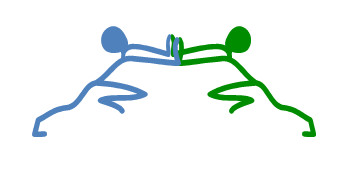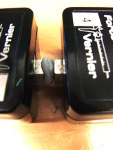Abstract
 Action-reaction forces are equal and opposite but can NEVER cancel because they are on different objects. This is widely misunderstood.
Action-reaction forces are equal and opposite but can NEVER cancel because they are on different objects. This is widely misunderstood.
Students memorize Newton’s Third Law but their answers to questions show that they misunderstand it.
This demonstration seeks to dispel the misconception that the two forces in an action-reaction pair can cancel or “balanceâ€.
Teacher commentary
In the diagram below, let’s call Blue pushing on Green the action and then Green pushing on Blue is the reaction. If students are asked which of these forces is larger, they all dutifully respond that the forces are of the same magnitude and in opposite directions. Use the force meters as shown in the photograph and short video clip below to verify this. As the two students vary the force, the action and reaction continue to be equal and opposite.
 But when students are asked why Blue and Green do not move, most say that the two forces in the action-reaction pair “balance†or “cancel”. This is completely incorrect: the action is a force on Green and the reaction is a force on Blue. There is no possibility that a force on Green can be balanced by a force on Blue. An amusing way to illustrate this is to let one student push another forward, and then have a third student try to prevent the acceleration of the student by pushing on a wall. Students quickly get the idea that forces can only balance or cancel when they are on the same object.
But when students are asked why Blue and Green do not move, most say that the two forces in the action-reaction pair “balance†or “cancel”. This is completely incorrect: the action is a force on Green and the reaction is a force on Blue. There is no possibility that a force on Green can be balanced by a force on Blue. An amusing way to illustrate this is to let one student push another forward, and then have a third student try to prevent the acceleration of the student by pushing on a wall. Students quickly get the idea that forces can only balance or cancel when they are on the same object.
Action reaction pairs can NEVER cancel under any circumstances because the two forces are on different objects.
The majority of our incoming first year students incorrectly believe that forces within an action-reaction pair can cancel.
So if the forces within the action-reaction pair cannot cancel, then why don’t Green and Blue move? Have the students sit on office chairs and push on each other to demonstrate that the force balancing the force Blue applies on Green is friction between Green’s feet and the floor. Similarly the force Green applies on Blue is balanced by friction on Blue’s feet.
  We should word Newton’s Third Law more carefully: for every action there is an equal and opposite reaction on the other object.
We should word Newton’s Third Law more carefully: for every action there is an equal and opposite reaction on the other object.
NCEA & Science Curriculum
Year 10Â forces
PHYS 2.4
Instructions
This demonstration can be enhanced using a pair of force meters as shown below. These are instructions for Vernier force meters and interfaces but the experiment should work with Pasco force meters as well. Without force meters you can download and use the video clips below.
1) Connect the force meters together. Here we have used older style Vernier force meters with rectangular extensions as shown in the photos. We have manufactured convenient plastic joiners, but actually Blu-Tack works almost as well.
2) Connect the force meters to the interface (LabPro, LabQUEST, etc) and connect the interface to the computer.
3) It is very convenient to set up the sensors so that one force is negative and the other positive. This is easy to do in LabPro software but you can download a .cmbl file that is already set up below. Just put it on your desktop and double-click to open it. LoggerPro will launch ready to run with the settings tailored for this experiment.
Setup file for Vernier LoggerPro (contact us).
Video:
Download larger image video (right-click and “save link as”, 3 MB): N3LawStatic.m4v
4) Point out to students that one force meter is measuring the force on one student while the other force meter is measuring the force on the other student. The action and reaction are equal and opposite but are on different objects. Then try the same experiment with reduced friction:
Video:
Download video (right-click and “save link as”, 0.6 MB)
Action-reactiononwheels.m4v
Safety
Individual teachers are responsible for safety in their own classes. Even familiar demonstrations should be practised and safety-checked by individual teachers before they are used in a classroom.
Related Resources
Credits
This teaching resource was developed with support from
The MacDiarmid Institute
Faculty of Science, Victoria University of Wellington
School of Chemical and Physical Sciences, Victoria University of Wellington


